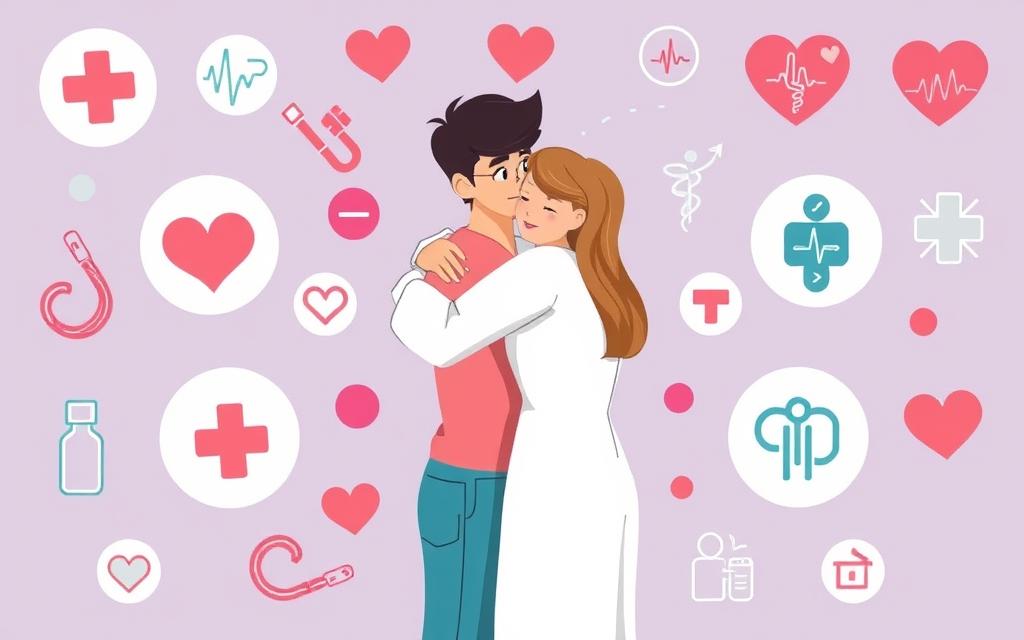HIV Myths Busted: What You Need to Know?
HIV Myths: Misconceptions about the virus have persisted for decades, often leading to unnecessary fear and stigma. This article aims to clarify the facts and dispel common misunderstandings. By addressing both historical beliefs and modern scientific evidence, we provide a clear picture of what is true and what is not.
Understanding how the virus is transmitted is crucial. Everyday interactions, such as shaking hands or sharing utensils, do not pose a risk. Accurate information helps reduce fear and promotes better support for those affected.
Our content is backed by trusted sources like the CDC, WHO, and Medical News Today. These organizations provide reliable data that helps separate fact from fiction. By the end of this article, you’ll have a better understanding of what constitutes real risk and what doesn’t.
Key Takeaways
- Misconceptions about the virus have caused unnecessary fear and stigma.
- Everyday interactions do not pose a risk of transmission.
- Historical beliefs often conflict with modern scientific evidence.
- Accurate information helps reduce fear and promotes support.
- Trusted sources like the CDC and WHO provide reliable data.
- Taboo Topics: Were Not Supposed to Talk About Sex.
Understanding HIV and AIDS: Separating Fact from Fiction
Understanding the difference between HIV and AIDS is essential to dispel confusion. Many people use these terms interchangeably, but they refer to different stages of the same condition. HIV (Human Immunodeficiency Virus) is the virus that can lead to AIDS (Acquired Immunodeficiency Syndrome) if left untreated. Knowing the facts helps reduce stigma and promotes better support for those affected.
Key Definitions
HIV is a virus that attacks the immune system, specifically targeting CD4 cells. Over time, if untreated, it weakens the body’s ability to fight infections. AIDS is the final stage of HIV infection, where the immune system is severely damaged. Not everyone with HIV develops AIDS, especially with proper treatment.
Early diagnosis and treatment can prevent the progression to AIDS. Modern antiretroviral therapy (ART) allows a person with HIV to live a healthy life. This highlights the importance of regular testing and access to care.
Historical Perspective
When HIV first emerged in the 1980s, it was surrounded by fear and misinformation. Many believed it was a death sentence, and stigma was widespread. Over the decades, scientific advancements have transformed our understanding of the disease.
Today, organizations like the CDC and WHO provide reliable information and guidelines. Early misconceptions have been replaced by facts, and effective treatment protocols are widely available. This progress has significantly improved the quality of life for those living with the virus.
The Science Behind HIV Transmission
The science behind transmission reveals how the virus moves from person to person. It spreads only through specific body fluids, such as blood, semen, vaginal fluids, and breast milk. Understanding these mechanisms helps dispel unnecessary fears and promotes accurate knowledge.
How HIV Spreads
The virus enters the body through direct contact with infected fluids. This can happen during unprotected sex, sharing needles, or from mother to child during childbirth or breastfeeding. Blood transfusions with infected blood were once a significant risk, but modern screening has nearly eliminated this route.
Tests play a crucial role in detecting the virus early. Regular testing ensures timely treatment, which can prevent the virus from progressing. Early detection also reduces the risk of transmission to others.
Myths About Non-Transmission
Casual contact, such as hugging, shaking hands, or sharing utensils, does not spread the virus. The virus cannot survive outside the body for long, making these activities safe. Scientific research has clarified these facts, reducing unnecessary fear.
Sexual contact remains a primary route of transmission. Factors like unprotected sex and multiple partners increase the risk. Using protection and getting tested regularly are effective ways to stay safe.
By understanding the science, we can focus on real risks and avoid misconceptions. This knowledge empowers individuals to make informed decisions and support those affected.
Debunking HIV Myths: What the Facts Really Say
Many false beliefs about the virus continue to spread, causing confusion and fear. These myths often stem from outdated information or misunderstandings about how the virus works. By addressing these misconceptions, we can help reduce stigma and promote accurate knowledge.
Common Misconceptions
One of the most persistent myths is that the virus can spread through casual contact, like hugging or sharing utensils. This is not true. The virus cannot survive outside the body for long, making these activities completely safe.
Another misconception is that early symptoms of the virus are unique and easily identifiable. In reality, many early symptoms, such as fever or fatigue, are common to other illnesses. This makes it essential to get tested rather than relying on symptoms alone.
Scientific research has shown that the virus does not spread through saliva, sweat, or tears. The body’s natural defenses, combined with medical advancements, have clarified these facts. Understanding this helps dispel unnecessary fear.
Accurate information is key to combating stigma. By separating fact from fiction, we can create a more supportive environment for those affected. Knowledge empowers individuals to make informed decisions and support others effectively.
HIV Myths in Sexual Health and Prevention
Sexual health education and sexual health awareness plays a vital role in preventing the spread of HIV. By understanding safe practices, individuals can significantly reduce their risk. Misinformation often leads to unnecessary fear, but accurate knowledge empowers people to make informed decisions.
Safe Sex Practices
Using a condom consistently is one of the most effective ways to prevent HIV transmission. Condoms act as a barrier, stopping the virus from passing between partners. They are also effective against other sexually transmitted infections.
Another powerful tool is PrEP (pre-exposure prophylaxis). This medication, taken daily, can reduce the risk of contracting HIV by a lot. It’s especially recommended for individuals at higher risk, such as those with multiple partners or a partner who is HIV-positive.
Role of Protective Barriers
Protective barriers like condoms and dental dams are essential for safe sex. They not only prevent HIV but also reduce the risk of other infections. For couples, open communication about protection is key to maintaining a healthy sexual relationship.
Single individuals can also protect themselves by being proactive. Regular testing, using condoms, and considering PrEP are all part of a comprehensive prevention strategy. By adopting these practices, everyone can enjoy a safer sexual lifestyle.
Importance of Regular HIV Testing
Regular testing is a cornerstone of maintaining good health and preventing the spread of infections. The CDC recommends that everyone between the ages of 18 and 64 get tested at least once. For those at higher risk, more frequent testing is advised. Early detection through testing allows for timely treatment, which can significantly improve outcomes.
Testing is not just about personal health; it also plays a vital role in public health. By identifying infections early, we can reduce the spread of the virus. This is especially important for individuals with multiple partners or those in high-risk situations. Knowing your status helps you and your partner make informed decisions about your health.
When to Get Tested
The right time to get tested depends on your exposure and risk factors. If you’ve had unprotected sex or shared needles, it’s crucial to get tested as soon as possible. Regular testing is also recommended for those in long-term relationships to ensure both partners are safe.
Testing is a proactive step toward managing your health. It reduces stigma by normalizing the process and encouraging open conversations. By staying informed and getting tested regularly, you take control of your well-being and contribute to a healthier community.
Effective HIV Treatment and Antiretroviral Therapy
Modern medicine has made significant strides in managing complex health issues effectively. One of the most notable advancements is in the field of antiretroviral therapy, which has transformed the way we approach treatment for certain conditions. Today, individuals can lead healthier lives thanks to simplified and more manageable medication options.
Treatment Options Overview
In the past, treatment often required taking multiple pills daily, which could be challenging to manage. Now, combination therapies have simplified regimens, making it easier for individuals to adhere to their medication plans. These advancements have not only improved quality of life but also reduced the risk of progression to more severe stages.
Antiretroviral therapy works by keeping viral levels low in the body. Regular blood tests are used to monitor the effectiveness of the treatment. This approach ensures that the therapy is working as intended and allows for adjustments if needed.
Modern medication options are more manageable than ever before. They come in various forms, including once-daily pills, which have significantly improved adherence rates. These advancements have been crucial in improving life expectancy over the years.
Early treatment is essential for long-term health. Starting therapy as soon as possible can prevent the virus from causing significant damage to the immune system. It also reduces the likelihood of progression to more advanced stages, ensuring better outcomes for individuals.
- Combination therapies have simplified treatment regimens.
- Regular blood tests monitor the effectiveness of therapy.
- Modern medication options are more manageable and effective.
- Early treatment improves long-term health outcomes.
Exploring Modern Advances in HIV Medication
Recent advancements in medical science have revolutionized treatment options for certain conditions. For someone managing a chronic condition, these innovations offer hope and improved quality of life. Modern medicine has introduced simplified regimens and new methods that make treatment more accessible and effective.
Once-Daily Pills vs. Injections
One of the most significant changes in treatment is the shift from complex regimens to once-daily pills. These medications are easier to manage and have greatly improved adherence rates. For a person hiv, this means fewer disruptions to daily life and better long-term outcomes.
Injectable treatments are another breakthrough. Unlike daily pills, these injections are administered less frequently, often monthly or bi-monthly. This option is ideal for someone who struggles with daily pill routines. Both methods have proven effective in controlling the condition and enhancing quality of life.
Role of PrEP in Prevention
PrEP (pre-exposure prophylaxis) has become a cornerstone of prevention strategies. This medicine, taken daily, significantly reduces the risk of transmission. When combined with modern treatment options, it offers a comprehensive approach to managing and preventing the condition.
For a person hiv, these advancements mean more choices and better control over their health. Whether opting for once-daily pills or injections, the focus is on improving adherence and outcomes. These innovations highlight the progress made in modern healthcare.
- Once-daily pills simplify treatment and improve adherence.
- Injectable options offer flexibility for those who prefer less frequent dosing.
- PrEP integrates seamlessly with modern prevention strategies.
- These advancements enhance the quality of life for someone managing the condition.
Understanding Viral Load and the Undetectable Status
Viral load is a critical measure in monitoring and treating certain infections. It refers to the amount of virus present in a person’s blood. For individuals managing a specific condition, keeping this level low is key to maintaining health and preventing complications.
An undetectable viral load means the virus is present in such small amounts that it cannot be detected by standard tests. Achieving this status is a major goal of treatment. It not only improves the individual’s health but also reduces the risk of transmission to others.
Consistent treatment is essential for lowering viral load. Antiretroviral therapy (ART) works by suppressing the virus, allowing the immune system to recover. Over time, this can lead to an undetectable status, which is a significant milestone in managing the condition.
Scientific studies, including those from the CDC, confirm that individuals with an undetectable viral level cannot transmit the virus sexually. This finding has been a game-changer in both treatment and prevention efforts. It highlights the importance of adherence to medication and regular monitoring.
Regular check-ups and blood tests are crucial for maintaining an undetectable status. These measures ensure that the treatment is effective and the virus remains suppressed. By staying consistent with therapy, individuals can lead healthier lives and protect their partners.
The Intersection of HIV, Health, and Lifestyle
Living a healthy lifestyle is essential for anyone, especially for those managing chronic conditions. Daily choices in diet, exercise, and mental well-being can significantly impact overall health and longevity. For a person living HIV, these habits are even more critical to maintaining a strong immune system and improving quality of life.
Healthy Lifestyle Choices
Proper nutrition is a cornerstone of good health. A balanced diet rich in fruits, vegetables, lean proteins, and whole grains supports the immune system and helps the body function optimally. For a person managing a chronic condition, this can make a noticeable difference in energy levels and overall well-being.
Regular exercise is another key factor. Physical activity not only strengthens the body but also reduces stress and improves mental health. Activities like walking, yoga, or swimming can be tailored to individual needs, making it easier to stay consistent.
Stress management is equally important. Practices such as meditation, deep breathing, or engaging in hobbies can help reduce anxiety and improve emotional resilience. For a person living HIV, managing stress is vital to maintaining both physical and mental health.
A balanced lifestyle complements medical treatment, leading to better outcomes. Proactive health management, including regular check-ups and adherence to medication, ensures that individuals can live their best life. By making informed choices, everyone can take control of their well-being and thrive.
Socioeconomic Factors and HIV Myths in the U.S.
Socioeconomic factors play a significant role in shaping health outcomes, particularly in minority communities. Access to healthcare, education, and economic stability often determine the quality of care a person receives. These disparities are especially evident in the context of hiv infection and aids.
Impact on Minority Communities
Minority populations in the U.S. often face barriers to healthcare access. These include lack of insurance, transportation issues, and limited availability of services. According to the cdc, these challenges contribute to higher rates of hiv infection in these communities.
Inaccurate beliefs about the condition can exacerbate stigma. For example, some people still think it can spread through casual contact. This myth discourages individuals from seeking testing or treatment. Addressing these misconceptions is crucial to improving health outcomes.
Real-life case studies show the impact of these disparities. One example is a community outreach program that increased testing rates by 30% in a single week. Such initiatives highlight the importance of education and access to care.
The cdc emphasizes the need for targeted interventions. These include expanding testing services, providing affordable treatment, and combating stigma. By addressing socioeconomic factors, we can reduce the burden of aids in vulnerable populations.
Efforts to improve healthcare access are making a difference. Awareness campaigns have led to increased testing and earlier diagnosis. This progress shows that with the right resources, communities can overcome these challenges.
Myth vs. Fact: Evidence-Based Research on HIV
Scientific evidence continues to debunk long-standing misconceptions about the condition. Organizations like the CDC and WHO have played a pivotal role in providing accurate information. Their research has clarified many misunderstandings, helping individuals make informed decisions about their health.
Insights from the CDC and WHO
The CDC emphasizes that the condition cannot spread through casual contact. Activities like hugging or sharing utensils are completely safe. Dr. Rosenberg, a leading expert, confirms that the virus requires specific conditions to transmit, such as direct exposure to infected fluids.
According to the WHO, early diagnosis and treatment are crucial. Modern ART (antiretroviral therapy) has transformed the condition into a manageable chronic illness. Regular testing ensures timely intervention, reducing the risk of progression to aids.
Medical Research Highlights
Recent studies highlight the effectiveness of PrEP (pre-exposure prophylaxis) in preventing transmission. When taken consistently, it reduces the risk by a lot. This medication is a game-changer for individuals at higher risk of exposure.
Another breakthrough is the development of long-acting injectable treatments. These options provide flexibility for those who struggle with daily pill regimens. Dr. Rosenberg notes that these advancements have significantly improved adherence rates and overall outcomes.
By relying on evidence-based research, we can separate fact from fiction. This approach not only reduces stigma but also empowers individuals to take control of their health. Accurate knowledge is the foundation of effective prevention and treatment.
In Conclusion
Advancements in medicine have reshaped how we approach health challenges. Understanding the facts is crucial for reducing fear and improving quality of life. Effective treatment and timely testing significantly lower the risk of complications, ensuring better outcomes for individuals.
Modern protocols, such as antiretroviral therapy, have transformed care. These innovations allow a person to manage their health effectively. By staying informed and consulting reliable sources like the CDC and WHO, individuals can make informed decisions.
Safe practices, such as regular testing and open communication with a partner, are essential. Every case of awareness and advocacy brings us closer to a healthier future. Together, we can continue to support research and education in this vital field.
FAQ: Common Myths and Facts About HIV
Q1. HIV is a death sentence?
Ans: No, HIV is not a death sentence. With proper treatment (antiretroviral therapy), people with HIV can live long, healthy lives and reduce the virus to undetectable levels, preventing transmission.
Q2. HIV symptoms are obvious?
Ans: No, HIV symptoms (fever, fatigue, rash) may not appear immediately or can be mild and flu-like. Many people are asymptomatic for years, making testing crucial.
Q3. HIV can be transferred by kissing?
Ans: No, HIV cannot be transmitted through kissing, saliva, or casual contact. It spreads through blood, semen, vaginal fluids, or breast milk.
Q4. HIV isn’t transmitted sexually?
Ans: Yes, HIV is primarily transmitted sexually through unprotected vaginal, anal, or oral sex with an infected person.
Q5. HIV is the same as AIDS?
Ans: No, HIV (Human Immunodeficiency Virus) is the virus that can lead to AIDS (Acquired Immunodeficiency Syndrome) if untreated. AIDS is the final stage of HIV infection.
Q6. HIV only affects gay men?
Ans: No, HIV can affect anyone regardless of sexual orientation. It spreads through unprotected sex, shared needles, or mother-to-child transmission.
Q7. Only lesbians get HIV?
Ans: No, HIV affects people of all sexual orientations. Heterosexual transmission accounts for a significant portion of HIV cases globally.
Q8. Birth control prevents HIV?
Ans: No, birth control does not prevent HIV. Only condoms, PrEP (pre-exposure prophylaxis), and safe practices reduce HIV transmission risk.
Q9. HIV doesn’t cause AIDS?
Ans: Yes, HIV causes AIDS if left untreated. Antiretroviral therapy (ART) prevents HIV from progressing to AIDS.
Understanding HIV facts helps combat stigma and promotes prevention, testing, and treatment. Always rely on accurate information and consult healthcare professionals.












